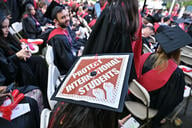You have /5 articles left.
Sign up for a free account or log in.

Student Voice survey data indicate that students over all value academic and social information and experiences equally.
Delpixart/iStock/Getty Images Plus
Edgar Quiroz Sanchez, a senior studying psychology and law, society and justice at the University of Washington at Seattle, has experienced new-student orientation from multiple perspectives. Today, he works as an orientation coordinator in the campus’s first-year programs office. Previously, he led orientation sessions. And in 2020, in the early months of COVID-19, he was a first-year student participating in a rapidly reimagined, all-online orientation.
Sanchez’s personal orientation experience may not have been what he expected, but he says it was still impactful—especially his time with his small-group orientation leader, then a student at the university.
“Just having that conversation with an actual student, I was able to ask him all the questions I had,” Sanchez recalls. “I feel like a lot of my anxieties were lessened.”
Beyond connecting with current and other incoming students, Sanchez’s own orientation accomplished several important things. Among them: he signed up for a first-year interest group, a cohort of incoming students who take certain classes together during their first quarter. He also met with an adviser in the university’s minority affairs and diversity office, who answered questions about his financial aid package and about being a first-generation student.
With help from an academic adviser and his orientation leader, Sanchez registered for classes as well.
“It made me feel very prepared academically.”
But what’s the primary function of orientation in Sanchez’s view? Building community, whatever that looks like to the individual student.
“That’s the No. 1 thing, just feeling support in general.”
How do Sanchez’s insights and experiences compare with other students’? According to the newest Student Voice survey from Inside Higher Ed and College Pulse, 29 percent of the 2,802 undergraduate respondents who attended some form of orientation rate their experience as excellent, and 44 percent rate it as good. The experience was fair for 21 percent and poor for 5 percent.
Modality Matters
Various factors drive orientation satisfaction. One is orientation modality, with more students seeming to prefer in-person orientations than virtual ones—with some qualifications. That is, among four-year students (n=2,289) who attended new-student orientation in person, 80 percent rate their experience excellent or good. But just 55 percent of four-year students who attended virtual orientations rate them as excellent or good. Meanwhile, among two-year college students (n=504), 86 percent rate both their virtual and their in-person experiences favorably.
Krista Soria, an assistant professor of leadership and counseling at the University of Idaho who has researched new-student orientations, says these and other findings suggest a “one-orientation-type-fits-all” won’t be effective across campuses. Students’ expectations and needs surrounding orientation may differ, highlighting the importance of assessing incoming students on these issues, she adds.
The vast majority of students in the survey, which had a total of 3,000 respondents from 170 colleges and universities, attended on-site or online orientations. But some 307 students attended hybrid orientations involving in-person and virtual components, which two-thirds of students rate favorably.
Smaller numbers of students attended a variety of specialized orientation experiences, and generally they rate them highly. Close to 100 respondents attended summer bridge programs or pre-orientation programs, such as those that involved living on campus for several days prior to the main orientation, and 86 percent of these students rated the experience as excellent or good, for example.
Orientation at the University of Washington at Seattle has been virtual since COVID-19, but the campus is reintroducing an in-person component this year. Courtney Saben, associate director or advising and orientation for first-year programs, says that all-online orientation formats increase access, since no one is required to travel to campus during, say, June or July to attend sessions.
At the same time, she says, there’s some demand among students and especially campus offices to reintroduce an on-site orientation element. So in addition to asynchronous and synchronous online orientation phases, the university will offer a one-day, in-person orientation next month, just prior to the start of classes.
What Orientation Should Cover
Student Voice survey data indicate that four-year college students value academic and social information and experiences equally. Asked what topics orientation should include, these students rank both social events and information about academic support highly. Similarly, students cite community-building efforts and information about academic expectations as top priorities.
Two-year college students tend to prioritize academic information over more social experiences, however. Just about a third of community college students each say it’s important that orientation include social events to meet other students and that it highlight extracurricular opportunities.
That said, there are some gaps between students’ top priorities for orientation and what students say they got out of their own orientation experiences.
Some findings:
- Three in five students say orientation helped them feel connected to their campus, while one in five feels strongly that orientation did not help them feel connected to their campus.
- Nearly half of students (44 percent) say that orientation helped them feel more comfortable accessing resources for students, but rates were lower among community college students (32 percent) and nonwhite students (37 percent, versus 51 percent of white students).
- Two in five students over all agree that orientation helped them feel more prepared for college, but rates were again lower than this for community college students and nonwhite students.
- A quarter of students say that orientation helped them make friends, but a slightly larger share (29 percent) feel strongly that orientation did not help them make friends. Four-year students who attended virtual orientations were especially dissatisfied on this point, with 47 percent of them saying the experience did not help them make friends (compared to 17 percent of two-year college students who attended online orientations).
About half of students say orientation familiarized them with campus facilities and layout, such as dining, housing and fitness services. This jumps to 62 percent when excluding students who only had a virtual orientation (n=1,725). Still, 44 percent of the virtual orientation group say their online experience helped them understand campus layouts and facilities.
About two in five students in the full sample of orientation attendees say their experience helped them gain knowledge of academic supports, academic expectations, their college’s online portals and campus apps. About the same share say orientation helped them register for classes.
Just three in 10 students each say orientation was successful in helping them connect with other students, familiarizing them with extracurricular opportunities and connecting them with campus staff they could turn to for help. Connecting with other students jumped to four in 10 when those attending a virtual-only orientation are filtered out, but the other two results stay about the same.
Crucial to mental health promotion efforts, 47 percent of students over all say it’s important for orientation to address mental health awareness. But just 25 percent of students say the orientation they attended familiarized them with mental health resources. This outcome was especially low for students who attended virtual orientations (15 percent) and highest for students who attended specialized experiences, such as a summer bridge program (35 percent).
Improving Orientation
A second, related insight from Soria from the University of Idaho: institutions may want to consider customizing orientation experiences based on individual students’ needs and expectations—something like a “choose-your-own orientation adventure.” It’s potentially challenging to organize, she adds, but “students who are looking for specific experiences in orientation will likely be more satisfied with the outcomes.”
Sanchez, the student coordinator at UW Seattle, agrees that students are seeking some degree of “autonomy” in their orientation experiences. This year, for instance, the university is offering a series of 10-plus student-led workshops that incoming students can choose to attend—on top of required programs. Workshop topics include living on campus or off and how curved grading works.
“I know that as a new student, I would have really loved to have been able to get exposed to that,” Sanchez says of curved grading, in particular.
Asked how they would improve orientation on their campuses, students in write-in comments suggest they want more practical knowledge up front, in addition to more structured activities for meeting peers and making friends.
Some examples:
“If I was in charge of orientation, I would definitely focus more on familiarizing students with the campus (like how to get [from] one place [to] another). One time when I had a meeting with my adviser, I was having trouble finding the building where we were supposed to meet, so much so that I was wandering on the street for twenty minutes lol. I think the campus tour should’ve been at the beginning of orientation and not the end.” —Student at a public university in Texas
“More activities for students to connect and get to know each other. After the general tour and group activities, students were let go to do whatever they want, but students such as myself didn’t have anyone to hang with so I spent the rest of the day by myself. I would hope to make more activities for students who want to find connections.” —Student at a public university in Illinois
“I would try to have students connect with each other more and show them how to use Canvas and other apps that are required. I would also explain more about how to register for classes rather than spend so much time learning songs and cheers.” —Student at a public university in Florida
Both Sanchez and Saben argue that the key to a successful orientation program is staying responsive to students’ changing needs. Sanchez adds, “We tell our orientation leaders that our program is not set in stone, and we will change things from one day to the other if something doesn’t work.”
What more would you like to know about our orientation findings? Submit your questions and suggestions here.





